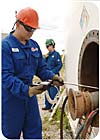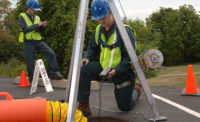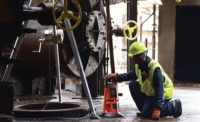
Since legislation regarding entry into confined spaces was established in 1993, safety professionals have been on a quest to find the ideal confined space gas monitor. The instrument must be easy to use, detects and identifies all potential hazards, lasts forever and requires no calibration, testing or preventive maintenance. Does such an instrument exist? Does the basic, low-cost, four-gas monitor generically referred to as a confined space meter really fit the bill as the ideal confined space gas detector?
To answer that question, you must understand what the standards require in a gas monitor used to perform atmospheric testing in confined spaces.
Display
First, the instrument must have a display. OSHA’s Standard 29 CFR1910.146 requires that the atmosphere of a confined space be tested with a “…direct reading instrument.” The instrument must display a reading of the concentration of the potential hazard in the appropriate units. That display should be crisp, easy to read, legible in low light as well as in bright ambient light or sunshine, and should clearly convey when the measured concentrations are above the limits established for safe entry into the space.The display should also help make using the instrument intuitive so that the operator is not so preoccupied with trying to understand the operation of the monitor that he or she is distracted from the entry task at hand.
Sampling pump
The confined space standard requires that the atmosphere within the space is monitored prior to entry. To do that means that the gas monitor should not be carried into the space before the atmosphere is checked, so the instrument must be equipped with a sampling pump. You may argue that the instrument could be lowered into the space from a vertical opening, however this is not possible if the area is accessed through a horizontal port. Whether the pump is integral, detachable or even just a simple hand pump does not matter much — the key is that the monitor is equipped with a pump to draw a sample from within the space to test the atmosphere prior to entry.What gases?
What gases will the monitor detect? The confined space standard says that the atmosphere must be tested for oxygen, combustible gas, and any toxic hazard that potentially may be found in the space. Where did the notion come from that a confined space monitor is always a four-gas meter with carbon monoxide and hydrogen sulfide sensors? If your confined space potentially may contain ammonia or chlorine, certainly that “standard” four-gas instrument is not going to be adequate.If there is potential for almost any hazardous vapor to exist in the space, such as in a sewer manhole, does the monitor need to have a sensor such as a PID capable of detecting almost anything? Maybe so, but it is critical to remember that while gas sensors such as PIDs are capable of detecting almost anything in the atmosphere, they do not have the capability to positively identify anything that they are detecting. A confined space monitor should provide flexibility in sensor options, so you can pick the right sensors to meet the monitoring needs of your confined space applications.
Calibration
Finally, the confined space standard says that the monitor used to assess the atmosphere of the space prior to entry must be calibrated. This is the part of confined space gas monitoring that workers despise the most. Furthermore, because there is no way to ensure that the monitor is actually capable of sensing gas other than exposing it to gas, it should be tested prior to each use with a known concentration of the target vapors.The processes of testing and calibration cannot be eliminated, but they can certainly be automated. A confined space monitor should be capable of being used with a docking system that automatically “bump” tests and calibrates the sensors, and documents the results so that they can be retrieved from a database at a later time. Some docking systems are capable of far more than that. It is possible to have an automated docking system that performs a full series of diagnostic tests on your gas monitor and sends that test information to the manufacturer so that factory service can be dispatched to keep the instrument fleet in top working condition.
Put all of the factors discussed here together in one instrument and, while you may not have found the perfect confined space gas monitor, chances are you will have addressed all your needs.
©2007 Industrial Scientific Corporation

